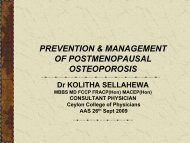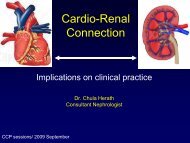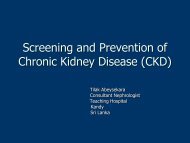COPING WITH ADVERSITY
COPING WITH ADVERSITY
COPING WITH ADVERSITY
You also want an ePaper? Increase the reach of your titles
YUMPU automatically turns print PDFs into web optimized ePapers that Google loves.
<strong>COPING</strong> <strong>WITH</strong><strong>ADVERSITY</strong>Stirling MooreySouth London and Maudsley NHS Foundation Trust &Institute of Psychiatry, London
Outline of presentation• A cognitive model of adjustment and coping• Coping styles associated with adjustment inWestern and Eastern populations• in general• in cancer patients• A simple cognitive behavioural approach tounderstand distress and facilitate coping• Effects of training home care nurses to useCBT techniques in palliative care
Cognitive Model ofAdjustment and Coping
A cognitive-behavioural model of stress and coping(adapted from Lazarus & Folkmann 1984, Folkman & Greer 2000)StressfuleventAppraisalEmotionalreaction
A cognitive-behavioural model of stress and coping(adapted from Lazarus & Folkmann 1984, Folkman & Greer 2000)Problem focused copingBeliefs, rules and assumptionsStressfuleventAppraisalEmotionalreactionCoping strategiesEmotion focused coping
Primary and secondary control(Weisz, Rothbaum & Blackburn 1984)• Primary control(more prominent in Western countries)individuals take control through their direct andactive influence on existing realities• Secondary control(more prominent in Eastern countries)individuals take control by accommodating andreframing their existing realities, leaving themessentially unchanged but exerting control over theirpersonal psychological impact.
Secondary control• predictive control• “attempts to accurately predict events and conditions so as tocontrol their impact on self” (e.g., avoid uncertainty, anxiety, orfuture disappointments)• vicarious control• “attempts to associate or closely align oneself with other individuals,groups or institutions so as to participate psychologically in thecontrol they exert”• illusory control• “attempts to associate or get into synchrony with chance so as toenhance comfort with and acceptance of one's fate”• interpretive control• “attempts to understand or construe existing realities so as to derivea sense of meaning or purpose from them and thereby enhanceone's satisfaction with them”
A cognitive-behavioural model of stress and coping(adapted from Lazarus & Folkmann 1984, Folkman & Greer 2000)Problem focused copingStressfuleventAppraisalEmotionalreactionCoping strategiesEmotion focused coping
Coping
Correlates of Coping• Finding hope• Dispositional Optimism, Learned Optimism• Finding strength• Perceived Control• Finding solutions• Confrontation v Avoidance, Fighting Spirit v Helplessness-Hopelessness, Problem-focused v Emotion-focused coping.• Finding meaning• Sense of Coherence, Benefit Finding, Cognitive Transformation• Finding support• Perceived social support• Finding acceptance• Emotional approach coping
But…Most studies have used Westernsamples
Comparison of coping amongstCanadian and Indian studentsBirendra & Watson 2007• Escape-avoidance associated withpsychological distress in Canadian studentsbut not Indian.• Locus of control associated withpsychological distress in Indian but notCanadian students.• Low self-esteem associated withpsychological distress in Canadian but notIndian students.
Collectivist coping(Yeh, Arora & Wu 2006)• proposed a new theoretical model of “collectivistcoping”• Includes• family support• respect for authority figures• intracultural coping• relational universality• forbearance• social activity• fatalism.
Coping with cancer
Appraisal and coping with a diagnosis of life threateningillness (Moorey & Greer 1989,2002)Appraisal Beliefs about coping Coping styleChallenge“I can exert control”Fighting SpiritDiagnosis cancerThreat“I don’t know if I cando anything about this”AnxiouspreoccupationHarm, lossor defeat“No one can exert control”Helplessness/hopelessnessMinimisationof threat“It’s in the hands ofGod or the doctors”“It’s better not to thinkabout it”FatalismDenial/positiveavoidance
Mental Adjustment to CancerScale (Watson et al 1988)• Fighting Spirit• Helplessness Hopelessness• Anxious Preoccupation• Fatalism• (Positive Avoidance)
Mental Adjustment to CancerScale (MAC)• Translated into Japanese, Chinese andKorean.
Mental Adjustment to CancerScale (MAC)• Factor analysis in Japanese sampleconfirmed same 4 factors as Western studies(Akechi et al 2000).
Mental Adjustment to CancerScale (MAC)• Factor analysis in Chinese sample (Ho et al 2008)identified 3 factors• Helpless Hopeless• Anxiety• Positive Attitude• Positive attitude includes Fighting Spirit andFatalism scales of original MAC (Ho et al 2003).• Positive attitude predicts postraumatic growth (Ho etal 2004).
Mental Adjustment to CancerScale (MAC)• Factor analysis in Korean sample (Kang et al2008) identified 4 factors• Helpless Hopeless• Anxious Preoccupation• Cognitive Avoidance• Positive Attitude• Positive attitude includes Fighting Spirit andFatalism scales of original MAC.
The basic cognitivemodel5 Areas Model (Padesky &Mooney 1988)
The Cognitive ModelENVIRONMENTCOGNITIONPHYSIOLOGYAFFECTBEHAVIOUR
SONIAPatient with metastatic bone disease from breast cancer.Analgesics worked when she was in hospital but when she wenthome, the pain seemed to break through the medication and shefelt she needed to take extra.This made her feel drowsy and she spent more time in bed. Whenshe felt her pain was increasing, she would start thinking abouther cancer diagnosis and would get very worried that having thepains meant that her cancer was getting worse.In bed she had nothing to take her mind off the pain and so shefocused on it even more, and it seemed to get worse and worse.Being in bed for long periods was uncomfortable and she noticednew pains that she started to worry about as more evidence thedisease was getting progressing faster.
Worry cycleSituationPain doesn’t seem to respond to medicationThoughtsMy cancer is getting worseI’m in pain all the timeWhy am I getting newpains?Physical sensationsMore painNew painsFeeling drowsyEmotionAnxietyBehaviourTake more medicationSpend more time in bedFocus on the pain
Depression trapSituationPain doesn’t seem to respond to medicationPhysical sensationsMore painNew painsFeeling drowsyThoughtsI’m in pain all the time.I can’t stop thinking aboutit.My cancer is getting worse.There’s nothing I can do.It’s all over.EmotionDepressionBehaviourTake more medicationSpend more time in bedTake more medicationSpend more time in bedLess interaction with family
Coping cycleThoughtsMy pain is not so badwhen I’m with people.If I find somethingpleasurable or useful todo, I feel less pain.Physical sensationsPain still there but lessall encompassing.Pain varies through theday.EmotionHopefulEncouragedBehaviourGet out of bedEngage in physical activityDistract myselfBe with people
Some basic CBTtechniques
Testing Negative AutomaticThoughts1. What’s the evidence?2. What alternatives are there?3. What’s the worst that could happen?4. What is the effect of thinking this way?
Behavioural Strategies• Activity scheduling• Graded task assignments• Behavioural experiments
A cluster randomised trial ofcognitive behaviour therapy forcommon mental disorders inpatients with advanced cancerStirling Moorey, Matthew Hotopf, Barbara Monroe, ElizabethCort, Marcia Kapari, Max Henderson, Julia Addington-Hall,Kathryn Mannix, Linda FisherSupported by the Gatsby Foundation
Aims of the Study• Can palliative care nurses use corecomponents of CBT in their everydaypractice?• Does this have an effect on patientoutcomes?
Ratings of knowledge and use of CBT techniquesKnowledge of cognitive model before and aftertrainingKnowledge of panic cycle before and after training2.521.51CBT groupControl group2.521.51CBT groupControl group0.50.50Pre-trainingPost-training0Pre-trainingPost-trainingTreatment plan for working with hopelessnessbefore and after trainingUse of CBT techniques2.532.5221.510.5CBT groupControl group1.510.5CBT groupControl group0Pre-trainingPost-training0Pre-trainingPost-training
CTFARS scores for CBT and control nurses atthe end of the study4035302520151050CBTControlCTFARS: Mannix et al (2006) Effectiveness of brief training in Cognitive BehaviourTherapy techniques for palliative care practitioners. Palliative Medicine 20: 579-584.
Conclusions• CBT training increases knowledge, skills andreported use of CBT techniques in palliativecare practice.• Nurses valued being given a psychologicalmodel and set of interventions.• There were significant time pressures fortraining and using techniques in clinicalpractice.
CBT Treatment• Minimum of 4 sessions• CBT techniques delivered in patients ownhomes• Integrated with usual physical palliative caresupport from home care nurses
Mean HAD Scores at Assessment forCBT and Treatment as Usual Group141210CBTTAUCBTTAU86420HAD AnxietyHAD DepressionCBT
4 6 810 12Mean HAD Anxiety Scores0 5 10 15weeksTAUCBT95% CI 95% CI
PercentageHAD Anxiety CasesHADA anxiety cases (HADA 10 or more)706050403020100Start ofsessions6 weeks 10 weeks 16 weeksAssessmentControlCBT
Percentage of patientsContact with otherprofessionals1009080706050403020100Baseline 6 weeks 10 weeks 16 weeksCBTTAUSocial work, chaplaincy, liaison psychiatry, complementary therapy, psychology
Conclusions• Nurses value the acquisition of psychosocial intervention skillsin palliative care.• Carrying out a study in this area is challenging:• 40% of patients may have physical, cognitive orcommunicative impairment which prevents thementering a trial• a further 40% of patients entering the study may not bewell enough to complete it• 12% may find the demands of structured treatment toogreat• fluctuations in physical state make regular treatmentdifficult and reduce the number of patients able tocomplete all assessments• Nurses trained in CBT have a greater impact on anxietysymptoms than nurses not trained in these methods.
• Moorey, S., Cort, E., Monroe, B., Hansford,P., Mannix, K., Fisher, L.& Hotopf, M.(2009) A Cluster Randomised Controlled TrialOf Cognitive Behaviour Therapy ForCommon Mental Disorders In Patients WithAdvanced Cancer. Psychological Medicine,39(5):713-23.
Summary• Coping with adversity can be understood in terms ofthe appraisals we make of stress, and our copingbehaviours.• There are few cross–cultural comparisons of coping.• In cancer, negative coping styles are broadly similar,but fatalism may be a more positive adjustmentstyle in Asian cultures.• Simple CBT techniques can be used by nurses toimprove coping in people with advanced cancer.
Stirling.moorey@slam.nhs.uk
















